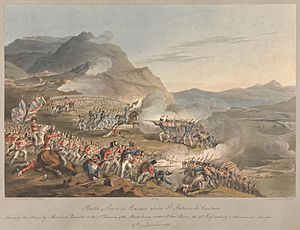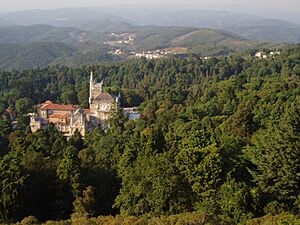Battle of Bussaco facts for kids
Quick facts for kids Battle of Bussaco |
|||||||
|---|---|---|---|---|---|---|---|
| Part of Peninsular War | |||||||
 British and Portuguese infantry deployed in line on the ridge at Bussaco |
|||||||
|
|||||||
| Belligerents | |||||||
| Commanders and leaders | |||||||
| Strength | |||||||
| 32,000-35,765 | 45,774-58,000 | ||||||
| Casualties and losses | |||||||
| 1,300-1,356 dead or wounded | 2,456-4,500 dead or wounded | ||||||
The Battle of Buçaco (also spelled Bussaco) was a major fight during the Peninsular War. It happened on September 27, 1810, in the mountains of Serra do Buçaco in Portugal. In this battle, the French army was defeated by the Anglo-Portuguese Army, led by Lord Wellington.
Wellington had about 50,000 British and Portuguese soldiers. They were positioned on a long ridge called Bussaco. The French, with around 60,000 soldiers, were led by Marshal André Masséna. The French attacked five times, but Wellington's troops held their ground. The French lost many more soldiers than the Allies. Even though the Allies won this battle, Wellington eventually had to move his army back to a strong defensive line called the Lines of Torres Vedras. This was because the French found a way around his position.
Contents
Why the Battle Happened
The Peninsular War was a long conflict where France fought against Spain, Portugal, and Britain. In 1810, the French Emperor Napoleon wanted to kick the British out of Portugal.
French Invasion of Portugal
Marshal Masséna, a top French general, began his march into Portugal. His goal was to capture Lisbon, the capital city. First, the French had to take some fortresses. They captured Ciudad Rodrigo and Almeida. With these out of the way, the path to Lisbon seemed open.
However, Lord Wellington had a plan. He wanted to slow down the French army. This would give him time to finish building huge defensive walls and forts around Lisbon, known as the Lines of Torres Vedras. Wellington destroyed bridges and roads to make the French advance difficult. By late September, the French army reached the Bussaco ridge, where Wellington's army was waiting.
The Bussaco ridge was a perfect place for defense. It was high, about 549 meters (1,800 feet) at its highest point. It also blocked the main road to Coimbra and then to Lisbon.
How the Armies Were Set Up
Lord Wellington carefully placed his army along the top of the Bussaco Ridge. His soldiers were mostly hidden on the "reverse slope," meaning they were on the side of the hill facing away from the French. This made it hard for the French to see how many soldiers there were or to hit them with cannons. Wellington even had a special road built along the ridge to move his troops quickly.
His army included six British infantry divisions and several Portuguese brigades. The Portuguese soldiers had been recently trained by British officers and were ready to fight. In total, the Anglo-Portuguese army had about 50,000 soldiers, with half of them being Portuguese.
Marshal Masséna's French army was larger, with about 60,000 soldiers. He had three main army groups, called corps, led by generals Jean Reynier, Michel Ney, and Jean Andoche Junot. Masséna thought he had more soldiers than Wellington and decided to attack the ridge directly instead of trying to go around it.
The Battle Begins
The battle started early in the morning, with a thick mist covering the ridge.
French Attacks on the Center
General Reynier's French troops attacked first. They marched straight up the steep slope in a very deep column formation. When the first French soldiers reached the top, they were met by British and Portuguese soldiers who were ready and waiting. The French tried to spread out into a line, but the Allies fired heavily at them. The French became confused and were pushed back down the hill.
Further north, another French division also attacked. But Wellington had quickly moved his defenders using the special road on the ridge. The French were again met with strong fire and were forced to retreat. One French general was badly wounded. Wellington praised the British soldiers for their brave charge.
Later, another French attack found a weak spot where a Portuguese militia unit was positioned. This unit was pushed back. But as the mist cleared, Wellington saw what was happening. He quickly sent more British and Portuguese soldiers to help. These fresh troops attacked the French, pushing them off the ridge.
French Attacks on the Main Road
Hearing the sounds of fighting, General Ney, another French commander, thought Reynier's attack was succeeding. So, he ordered his own troops to attack the main road leading up to the ridge.
His soldiers fought their way up against strong British skirmishers (soldiers who fight in small groups). Near the top, two British regiments, the 43rd and 52nd, were lying down, waiting. As the French came close, the British soldiers stood up, fired a powerful volley of shots from very close range, and then charged with bayonets. The French soldiers were completely broken and ran away. Their commander was wounded and captured.
Another French attack also failed, meeting heavy cannon fire and musket shots from the British and Portuguese. A final push by another French brigade was also defeated by a Portuguese brigade. The fighting continued with smaller skirmishes for the rest of the day, but the French did not try another large attack.
What Happened Next
The battle was a clear victory for the Anglo-Portuguese army. The French suffered heavy losses, with over 4,500 soldiers killed or wounded. The Allies had far fewer casualties, about 1,250.
After the battle, Masséna realized how strong Wellington's position was. That afternoon, he found a way to go around the ridge to the north. Wellington saw this and decided to continue his planned retreat. He slowly moved his army back towards the Lines of Torres Vedras, reaching them safely by October 10.
Masséna continued to advance, but he had to leave his sick and wounded soldiers behind in Coimbra. These soldiers were later captured by the Portuguese.
The Battle of Bussaco was very important for the Portuguese army. It was their first major battle after being reorganized and trained by the British. Their strong performance boosted their confidence and morale.
The French army eventually reached the Lines of Torres Vedras but found them too strong to attack. Masséna's army then had to spend the winter without enough food and constantly harassed by Anglo-Portuguese attacks. He lost many more soldiers to starvation and sickness. In early 1811, Masséna was forced to retreat back into Spain, finally freeing Portugal from French occupation.
In Books and Movies
The Battle of Bussaco has been featured in several stories:
- Under Wellington's Command by G.A. Henty includes a part about the battle.
- Sharpe's Escape by Bernard Cornwell covers the battle in detail.
- Stranger from the Sea by Winston Graham mentions the battle when a character visits the front line.
Images for kids



